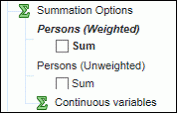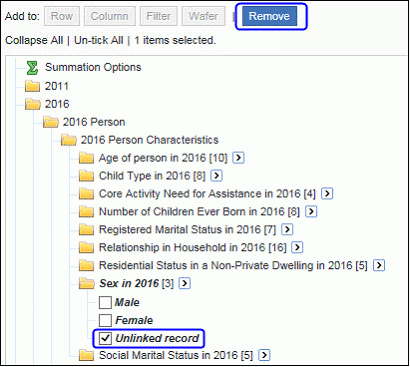ACLD 2006-2011-2016-2021 linkage rates by selected characteristics (a)| | 2006 panel sample (no.) | 2006-2011 linked records (no.) | 2006-2011 linkage rate (%) | 2006-2011-2016 linked records (no.) | 2006-2011-2016 linkage rate (%) | 2006-2011-2016-2021 linked records (no.) | 2006-2011-2016-2021 linkage rate (%) |
|---|
| SEX | | Male | 480,288 | 364,718 | 76 | 288,893 | 60 | 236,062 | 49 | | Female | 499,374 | 392,227 | 79 | 316,725 | 63 | 265,879 | 53 | | | | AGE GROUP | | 0-14 | 194,017 | 141,566 | 73 | 114,539 | 59 | 99,791 | 51 | | 15-19 | 66,248 | 48,704 | 73 | 33,780 | 51 | 28,563 | 43 | | 20-24 | 66,510 | 45,596 | 69 | 32,890 | 50 | 28,085 | 42 | | 25-29 | 62,249 | 46,282 | 74 | 36,610 | 59 | 31,236 | 50 | | 30-39 | 140,271 | 113,886 | 81 | 95,333 | 68 | 82,203 | 59 | | 40-49 | 142,910 | 120,929 | 85 | 103,465 | 72 | 88,893 | 62 | | 50-59 | 126,284 | 107,382 | 85 | 92,006 | 73 | 78,042 | 62 | | 60-69 | 86,388 | 72,043 | 83 | 60,182 | 70 | 46,756 | 54 | | 70-74 | 31,004 | 24,252 | 78 | 18,230 | 59 | 11,377 | 37 | | 75 and over | 63,781 | 36,305 | 57 | 18,583 | 29 | 6,995 | 11 | | | | INDIGENOUS STATUS | | Non-Indigenous | 942,256 | 733,035 | 78 | 588,536 | 63 | 489,572 | 52 | | Aboriginal | 19,697 | 12,450 | 63 | 8,763 | 45 | 6,218 | 32 | | Torres Strait Island | 1,451 | 938 | 65 | 674 | 47 | 500 | 35 | | Both Aboriginal and Torres Strait Islander | 839 | 504 | 60 | 360 | 43 | 252 | 30 | | Not stated | 15,419 | 10,018 | 65 | 7,285 | 47 | 5,399 | 35 | | | | STATE/TERRITORY OF USUAL RESIDENCE | | New South Wales | 323,137 | 250,070 | 77 | 199,419 | 62 | 165,389 | 51 | | Victoria | 244,098 | 191,982 | 79 | 154,280 | 63 | 129,237 | 53 | | Queensland | 192,609 | 144,428 | 75 | 114,858 | 60 | 94,070 | 49 | | South Australia | 75,479 | 59,387 | 79 | 48,423 | 64 | 40,136 | 53 | | Western Australia | 95,795 | 73,946 | 77 | 59,261 | 62 | 48,822 | 51 | | Tasmania | 23,784 | 18,624 | 78 | 14,815 | 62 | 12,343 | 52 | | Northern Territory | 8,466 | 5,575 | 66 | 4,055 | 48 | 3,022 | 36 | | Australian Capital Territory | 16,188 | 12,864 | 80 | 10,453 | 65 | 8,892 | 55 | | Other Territories | 106 | 69 | 65 | 54 | 51 | 30 | 28 | | | | REMOTE AREAS | | Major Cities | 669,275 | 523,472 | 78 | 420,691 | 63 | 351,472 | 53 | | Inner Regional | 195,399 | 150,723 | 77 | 120,320 | 62 | 99,014 | 51 | | Outer Regional | 92,395 | 68,940 | 75 | 54,285 | 59 | 43,734 | 47 | | Remote | 13,986 | 9,843 | 70 | 7,540 | 54 | 5,884 | 42 | | Very Remote | 6,547 | 3,967 | 61 | 2,782 | 43 | 1,837 | 28 | | No Usual Address | 2,026 | 0 | 0 | 0 | 0 | 0 | 0 | | Migratory | 34 | 0 | 0 | 0 | 0 | 0 | 0 | | | | | | | | | | | TOTAL (b)(c) | 979,662 | 756,945 | 77 | 605,618 | 62 | 501,941 | 51 | - Due to different confidentialisation methods used, data presented in the table may not align with other published counts.
- Includes Other Territories.
- Includes Migratory areas.
|

